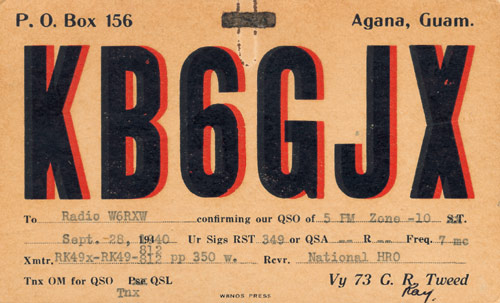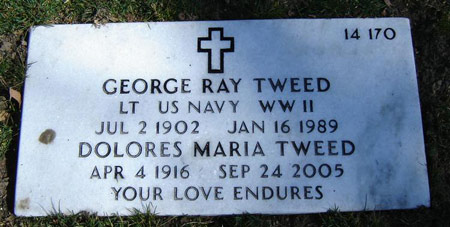

KB6GJX 1940 Guam
George Ray Tweed (Silent Key,
1902-1989).
Tweed was the son of Rev. Ole O. and Julia Tweed. His father was
born in Norway and came to the U.S. in 1880.
Tweed enlisted in the U.S. Navy on December 7, 1922. In 1940 a
U.S. census enumerator found George R. Tweed, his wife and son
living in Agana, Guam. Tweed was a U.S. Navy radioman. On October
17, 1941, Mrs. George R. Tweed and son departed Guam aboard the
U.S.S. Henderson.
On December 8, 1941, the American garrison on Guam was attacked
and defeated by Japanese forces. After the attack on Pearl Harbor
December 7, 1941, Japanese forces soon overran Guam Island in the
Pacific. Tweed, then serving as a Navy radioman with several
other U.S. personal slipped into the jungle rather than
surrender. He became the only survivor after the others were
captured and killed. He managed to elude Japanese soldiers for
two years seven months, providing information to American forces
that recaptured Guam Island in July 1944. His survival effort is
considered one of the greatest feats in war history to date. For
his contributions to the Pacific War victory, he was awarded the
Legion of Merit Medal, Silver Star Medal and a Presidential
Citation. He retired from the Navy as a Lieutenant. His story was
told in the best selling 1945 book, ''Robinson Crusoe USN'' and
in the Universal Studios 1962 movie, ''No Man is an Island,''
starring Jeffrey Hunter as George Tweed. Cause of death, an
automobile accident in Northern California (bio courtesy of John
"J-Cat" Griffith). Tweed was the author of the book
Robinson Crusoe, U.S.N.: The Adventures of George R. Tweed, Rm1
on Japanese-Held Guam.

Eagle Point National Cemetery, Eagle Point, Oregon.
QSL from the estate of W6RXW,
W6TC
Info courtesy of W5KNE